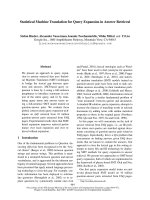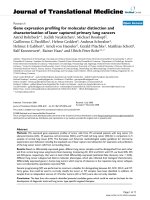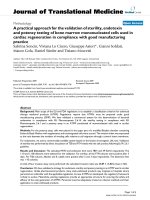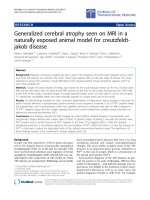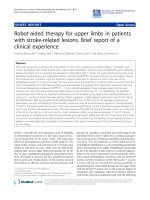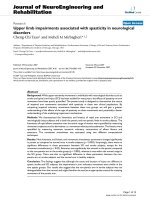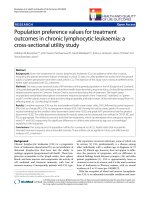Báo cáo hóa học: " Approximating fixed points for nonself mappings in CAT(0) spaces" pptx
Bạn đang xem bản rút gọn của tài liệu. Xem và tải ngay bản đầy đủ của tài liệu tại đây (237.05 KB, 7 trang )
RESEARC H Open Access
Approximating fixed points for nonself mappings
in CAT(0) spaces
Abdolrahman Razani and Saeed Shabani
*
* Correspondence: s.
Department of Mathematics,
Science and Research Branch,
Islamic Azad University, Tehran, Iran
Abstract
Suppose K is a nonempty closed convex subset of a complete CAT(0) space X with
the neares t point proje ction P from X onto K. Let T : K ® X be a nonself mapping,
satisfying Condition (E)withF(T): = {x Î K : Tx = x} ≠ ∅. Suppose {x
n
} is generated
iteratively by x
1
Î K, x
n+1
= P ((1 - a
n
)x
n
⊕ a
n
TP [(1 - b
n
)x
n
⊕ b
n
Tx
n
]),n ≥ 1, where
{a
n
} and {b
n
} are real sequences in [ε,1-ε] for some ε Î (0, 1). Then, {x
n
}
Δ-converges to some point x
⋆
in F(T). This extends a result of Laowang and Panyanak
[Fixed Point Theory Appl. 367274, 11 (2010)] for nonself mappings satisfying
Condition (E ).
Keywords: CAT(0) spaces, fixed point, condition (E), nonself mappings
1 Introduction
In 2010, Laowang and Panyanak [1] studied an iterative scheme and proved the follow-
ing result: let K be a nonempty closed convex subset of a complete CAT(0) space X,
(the initials of term “CAT” are in honor of E. Cartan, A.D. Alexanderov and V.A.
Toponogov) with the nearest point projection P from X onto K.LetT : K ® X be a
nonexpansive nonself mapping with nonempty fixed point set. If {x
n
} is generated itera-
tively by
x
1
∈ K, x
n+1
= P((1 − α
n
)x
n
⊕ α
n
TP[(1 − β
n
)x
n
⊕ β
n
Tx
n
]),
(1:1)
where {a
n
}and{b
n
} are real sequences in [ε,1-ε]forsomeε Î (0, 1), then {x
n
}is
Δ-convergent to a fixed point of T. In this article, this result is extended for nonself
mappings satisfying Condition (E).
Let K beanonemptysubsetofaCAT(0)spaceX and T : K ® X beamapping.A
point x Î K is calle d a fixed point of T,ifx = Tx. We shall denote the fixed point set of
T by F(T). Moreover, T is called nonexpansive if for each x, y Î K, d(Tx, Ty) ≤ d(x, y).
In 2011, Falset et al. [2] introduced Condition (E) as follows:
Definition 1.1.LetK be a bounded closed convex subset of a complete CAT(0)
space X. A mapping T : K ® X is called to satisfy Condition (E
μ
)onC, if there exists
μ ≥ 1 such that
d(x, Ty ) ≤ μd(Tx, x)+d(x, y)
holds, for all x, y Î K. It is called, T satisfies Condition (E)onC whenever T satisfies
(E
μ
) for some μ ≥ 1.
Razani and Shabani Fixed Point Theory and Applications 2011, 2011:65
/>© 2011 Razani and Shabani; licensee Springer. This is an Open Access article distribu ted under the terms of the Creative Commons
Attribution License ( nses/by/2.0), which permits unres tricted use, distribution, and reproduction in
any medium, provided the original work is properly cited.
Proposition 1.2 [2]. Every nonexpansive mapping satisfies Condition (E), but the
inverse is not true.
Now, we need some fact about CAT(0) spaces as follows:
Let (X, d) be a metric space. A geodesic path joining x Î X to y Î X (or, more briefly, a
geodesic from x to y) is a map c from a closed interval [0, l] ⊂ R to X such that c(0) = x, c
(l)=y and d(c(t), c(t’)) = ||t - t’|| for all t, t’ Î [0, l]. In particular, c is an isometry and d(x,
y)=l. The image a of c is called a geodesic (or metric) segment joining x and y. When it
is unique, this geodesic is denoted by [x, y]. The space (X, d) is said to be a geodesic space,
if every two points of X are joined by a geodesic, and X is said to be uniquely geodesic if
there is exactly one geodesic joining x to y,
for each x, y Î X. A subset Y ⊂ X is said to be
convex if Y includes every geodesic segment joining any two of its points. A geodesic
triangle Δ(x
1
, x
2
, x
3
) in a geodesic metric space (X, d) consists of three points in X (the
vertices of Δ) and a geodesic segment between e ach pair of vertices (the edges of Δ). A
comparison triangle for geodesic triangle Δ(x
1
, x
2
, x
3
)in(X, d) is a triangle
¯
(x
1
, x
2
, x
3
):=(
¯
x
1
,
¯
x
2
,
¯
x
3
)
in the Euclidean plane E
2
such that
d
E
2
(
¯
x
i
,
¯
x
j
)=d(x
i
, x
j
)
for
i, j Î {1, 2, 3}. A geodesic metric space is said to be a CAT(0) space [3], if all geodesic tri-
angles of appropriate size satisfy the following comparison axiom. Let Δ be a geodesic tri-
angle in X and
¯
be a comparison triangle for Δ.ThenΔ is said to satisfy the CAT(0)
inequality if for all x, y Î Δ and all comparison points
¯
x,
¯
y ∈
¯
,
d(x, y) ≤ d
E
2
(
¯
x,
¯
y).
(1:2)
If x, y
1
, y
2
are points in a CAT(0) space and y
0
is the midpoint of the segment [y
1
,
y
2
], then the CAT(0) inequality implies
d(x, y
0
)
2
≤
1
2
d(x, y
1
)
2
+
1
2
d(x, y
2
)
2
−
1
4
d(y
1
, y
2
)
2
.
(CN)
In fact, a geodesic space is a CAT(0) space if and only if it satisfies the (CN) inequal-
ity (Courbure negative)[[3], p. 163].
Lemma 1.3. Let (X, d) be a CAT(0) space.
1. [[3], Proposition 2.4] LetKbeaconvexsubsetofXwhichiscompleteinthe
induced metric. Then for every x Î X, there exists a unique point P(x) Î Ksuch
that d(x, P(x)) = inf{d(x , y): y Î K}.Moreover, the map x ® P(x) is a nonexpansive
retract from X onto K.
2. [[4], Lemma 2.1] For x, y Î XandtÎ [0, 1], there exists a unique point z Î [x,
y] such that
d(x, z)=td(x, y), d(y, z)=(1− t)d(x, y)
one uses the notation (1 - t)x ⊕ ty for the unique point z.
3. [[4], Lemma 2.4] For x, y, z Î X and t Î [0, 1], one has
d((1 − t)x ⊕ ty, z) ≤ (1 − t)d(x, z)+td(y, z).
[[4], Lemma 2.5] For x, y, z Î X and t Î [0, 1], one has
d((1 − t)x ⊕ ty, z)
2
≤ (1 − t)d(x, z)
2
+ td(y, z)
2
− t(1 − t)d(x, y)
2
.
Razani and Shabani Fixed Point Theory and Applications 2011, 2011:65
/>Page 2 of 7
Let {x
n
} be a bounded sequence in a CAT(0) space X. For x Î X, we set
r(x, {x
n
}) = lim sup
n→∞
d(x, x
n
).
The asymptotic radius
r({x
n
})=inf{r(x, {x
n
}):x ∈ X},
and the asymptotic center A({x
n
}) of {x
n
} is the set
A({x
n
})={x ∈ X : r(x, {x
n
})=r({x
n
})}.
It is known [[5], Proposi tion 7], in a CAT(0) space X, A({x
n
}) consists of exactly one
point.
Definition 1.4. [[6], Definition 3.1] A sequence {x
n
} in a CAT(0) space X is said
Δ-converges to x Î X,ifx is the unique asymptotic center of {u
n
}foreverysubse-
quence {u
n
}of{x
n
}. In this case, one can write Δ - lim
n
x
n
= x and ca ll x the Δ - lim
of {x
n
}.
Lemma 1.5. Let (X, d) be a CAT(0) space.
1. [[6], p. 3690] Every bounded sequence in X has a Δ-convergent subsequence.
2. [[7], Proposition 2.1] If K is a closed convex subset of X and if {x
n
} is a bounded
sequence in K, then the asymptotic center of {x
n
} is in K.
3. [[4], Lemma 2.8] If {x
n
} is a bounded sequence in X with A({x
n
}) = {x} and {u
n
} is
asubsequenceof{x
n
} with A({u
n
}) = {u} and the sequence {d(x
n
, u)} converges, then
x = u.
2 Main results
The following lemma was proved by Dhompongsa and Panyanak in the cas e of nonex-
pansive [[4], Lemma 2.10].
Lemma 2.1. Let K be a nonempty closed convex subset of a complete CAT(0) space X,
and T : K ® X be a nonself mapping, satisfying Condition (E).Suppose{x
n
} is a
bounded sequence in K such that lim
n
d(x
n
, Tx
n
)=0and {d(x
n
, v)} co nverg es for all v
Î F (T). Then
ω
w
(x
n
) ⊂ F(T),
where
ω
w
(x
n
):=
A({u
n
})
and the union is taken over all subsequences {u
n
} of {x
n
}.
Moreover, ω
w
(x
n
) consists of exactly one point.
Proof.Letu Î ω
w
(x
n
), then there exists a subsequence {u
n
}of{x
n
} such that A({u
n
})
={u}. By part (1) and (2) of Lemma 1.5, there exists a subsequence { v
n
}of{u
n
}such
that Δ - lim
n
v
n
= v Î K.Weshowv Î F (T). In order to prove this, by Condition (E),
one can write
d(x
n
, Tv) ≤ μd(Tx
n
, x
n
)+d(x
n
, v)
for some μ ≥ 1. Therefore
lim sup
n
d(x
n
, Tv) ≤ lim sup
n
(μd(Tx
n
, x
n
)+d(x
n
, v))
= lim sup
n
d(x
n
, v).
Razani and Shabani Fixed Point Theory and Applications 2011, 2011:65
/>Page 3 of 7
The uniqueness of asymptotic center, implies v Î K and T(v)=v. By part (3) Lemma
1.5, u = v. Therefore ω
w
(x
n
) ⊂ F(T). Let {u
n
}beasubsequenceof{x
n
}withA({u
n
}) =
{u} and A({x
n
}) = {x}. Since u Î ω
w
(x
n
) ⊂ F(T), {d(x
n
, v)} converges. By part (3) Lemma
1.5, x = u. This shows that ω
w
(x
n
) consists of exactly one point. □
Theorem 2.2. Let K be a nonempty closed convex subset of a complete CAT(0) space
X, and T : K ® X be a nonself mapping, satisfying Condition (E) with x
⋆
Î F(T)={x Î
K : Tx = x}.Let{a
n
} and {b
n
} be sequences in [ε,1-ε] for some ε Î (0, 1). Starting
from arbitrar y x
1
Î K, define the sequence {x
n
} by x
n+1
= P((1 - a
n
)x
n
⊕ a
n
TP[(1 - b
n
)
x
n
⊕ b
n
Tx
n
]),n≥ 1. Then lim
n®∞
d(x
n
, x
⋆
) exists.
Proof. By part (1) of Lemma 1.3, the nearest point projection P from X onto K is
nonexpansive. Then,
d(x
n+1
, x
)=d(P((1 − α
n
)x
n
⊕ α
n
TP[(1 − β
n
)x
n
⊕ β
n
Tx
n
]), Px
)
≤ d((1 − α
n
)x
n
⊕ α
n
TP[(1 − β
n
)x
n
⊕ β
n
Tx
n
], x
)
=(1− α
n
)d(x
n
, x
)+α
n
d(TP[(1 − β
n
)x
n
⊕ β
n
Tx
n
], x
).
But by Condition (E), for some μ ≥ 1, we have
(1 − α
n
)d(x
n
, x
)+α
n
d(TP[(1 − β
n
)x
n
⊕ β
n
Tx
n
], x
)
≤ (1 − α
n
)d(x
n
, x
)+α
n
(μd(Tx
, x
)+d(P[(1 − β
n
)x
n
⊕ β
n
Tx
n
], x
))
≤ (1 − α
n
)d(x
n
, x
)+α
n
[(1 − β
n
)d(x
n
, x
)+β
n
d(x
n
, x
)]
=d(x
n
, x
).
Consequently, d(x
n+1
, x
⋆
) ≤ d(x
n
, x
⋆
). Then d(x
n
, x
⋆
) ≤ d(x
1
, x
⋆
)foralln ≥ 1. This
implies
{d(x
n
, x
)}
∞
n=1
is bounded and decreasing. Hence, lim
n®∞
d(x
n
, x
⋆
) exists. □
Theorem 2.3. Let K be a nonempty closed convex subset of a complete CAT(0) space
X, and T : K ® X be a nonself mapping, satisfying Condition (E) with F( T) ≠ ∅.Let
{a
n
} and {b
n
} be sequences in [ε,1-ε] for some ε Î (0, 1). Starting from arbitrary x
1
Î
K, define the sequence {x
n
} by x
n+1
= P((1 - a
n
)x
n
⊕ a
n
TP [(1 - b
n
)x
n
⊕ b
n
Tx
n
]),n≥ 1.
Then lim
n®∞
d(x
n
, Tx
n
)=0.
Proof. Let x
⋆
Î F(T). By Theorem 2.2, lim
n®∞
d(x
n
, x
⋆
) exists. Set
lim
n→∞
d(x
n
, x
)=r.
If r = 0, by the Condition (E), for some μ ≥ 1,
d(x
n
, Tx
n
) ≤ d(x
, x
n
)+d(x
, Tx
n
)
≤ d(x
, x
n
)+μd(x
, Tx
)+d(x
, x
n
).
Therefore lim
n®∞
d(x
n
, Tx
n
)=0.
If r>0, set y
n
= P [(1 - b
n
)x
n
⊕ b
n
Tx
n
]. By part (4) of Lemma 1.3,
d(y
n
, x
)
2
=d(P[(1 − β
n
)x
n
⊕ β
n
Tx
n
], Px
)
2
≤ d([(1 − β
n
)x
n
⊕ β
n
Tx
n
], x
)
2
≤ (1 − β
n
)d(x
n
, x
)
2
+ β
n
d(Tx
n
, x
)
2
− β
n
(1 − β
n
)d(x
n
, Tx
n
)
2
≤ (1 − β
n
)d(x
n
, x
)
2
+ β
n
d(Tx
n
, x
)
2
.
(2:3)
Razani and Shabani Fixed Point Theory and Applications 2011, 2011:65
/>Page 4 of 7
Using Condition (E), for some μ ≥ 1,
(1 − β
n
)d(x
n
, x
)
2
+ β
n
d(Tx
n
, x
)
2
≤ (1 − β
n
)d(x
n
, x
)
2
+ β
n
(μd(Tx
, x
)+d(x
n
, x
))
2
=d(x
n
, x
)
2
.
(2:4)
Therefore by inequities (2.3) and (2.4), one can get
d(y
n
, x
) ≤ d(x
n
, x
).
(2:5)
Part (4) of Lemma 1.3, shows
d(x
n+1
, x
)
2
=d(P[(1 − α
n
)x
n
⊕ α
n
Ty
n
], Px
)
2
≤ d((1 − α
n
)x
n
⊕ α
n
Ty
n
, x
)
2
≤ (1 − α
n
)d(x
n
, x
)
2
+ α
n
d(Ty
n
, x
)
2
− α
n
(1 − α
n
)d(x
n
, Ty
n
)
2
≤ (1 − α
n
)d(x
n
, x
)
2
+ α
n
(μd(Tx
, x
)+d(y
n
, x
))
2
− α
n
(1 − α
n
)d(x
n
, Ty
n
)
2
=(1− α
n
)d(x
n
, x
)
2
+ α
n
d(y
n
, x
)
2
− α
n
(1 − α
n
)d(x
n
, Ty
n
)
2
≤ (1 − α
n
)d(x
n
, x
)
2
+ α
n
d(x
n
, x
)
2
− α
n
(1 − α
n
)d(x
n
, Ty
n
)
2
=d(x
n
, x
)
2
− α
n
(1 − α
n
)d(x
n
, Ty
n
)
2
.
Therefore
d(x
n+1
, x
)
2
≤ d(x
n
, x
)
2
− W(α
n
)d(x
n
, Ty
n
)
2
,
where W(a)=a(1 - a). Since a Î [ε,1-ε], W(a
n
) ≥ ε
2
.
Therefore
ε
2
∞
n=1
d(x
n
, Ty
n
)
2
≤ d(x
1
, x
)
2
< ∞.
This implies lim
n®∞
d(x
n
, Ty
n
)=0.
By Condition (E), for some μ ≥ 1, we have
d(x
n
, x
) ≤ d(x
n
, Ty
n
)+d(Ty
n
, x
)
≤ d(x
n
, Ty
n
)+μd(Tx
, x
)+d(y
n
, x
)
=d(x
n
, Ty
n
)+d(y
n
, x
).
Hence
r ≤ lim inf
n→∞
d(y
n
, x
).
On the other hand, from (2.5),
lim sup
n→∞
d(y
n
, x
) ≤ r.
This implies
lim
n→∞
d(y
n
, x
)=r.
Razani and Shabani Fixed Point Theory and Applications 2011, 2011:65
/>Page 5 of 7
Thus (2.5) shows
lim
n→∞
d((1 − β
n
)x
n
⊕ β
n
Tx
n
], x
)=r.
Since T satisfies Condition (E ), we have
d(Tx
n
, x
) ≤ μd(Tx
, x
)+d(x
n
, x
)
=d(x
n
, x
)
Thus
lim sup
n→∞
d(Tx
n
, x
) ≤ r.
Now, by [[1], Lemma 2.9], lim
n®∞
d(x
n
, Tx
n
)=0.□
Theorem 2.4. Let K be a nonempty closed convex subset of a complete CAT(0) space
X, and T : K ® X be a nonself mapping, satisfying Condition (E) with F(T) ≠ ∅.
Assume {a
n
} and {b
n
} are sequences in [ε,1-ε] for some ε Î (0, 1). Starting from arbi-
trary x
1
Î K, define the sequence {x
n
} by x
n+1
= P((1 - a
n
) x
n
⊕ a
n
TP[(1 - b
n
)x
n
⊕
b
n
Tx
n
]),n≥ 1. Then {x
n
} is Δ-convergent to some point x
⋆
in F(T).
Proof.ByTheorem2.3,lim
n®∞
d(x
n
, Tx
n
) = 0. The proof of Theorem 2.2 shows {d
(x
n
, v)} is bounded and decreasing for each v Î F (T), and so it is c onvergent. By
Lemma 2.1, ω
w
(x
n
) consists e xactly one point which is a fixed point of T.Conse-
quently, the sequence { x
n
}isΔ-convergent to some point x
⋆
in F(T). □
The following definition is recalled from [8].
Definition 2.5.AmappingT : K ® X is said to satisfy Condition I, if there exists a
nondecreasing function f :[0,∞) ® [0, ∞)withf(0) = 0 and f(r)>0forallr>0such
that
d(x, Tx) ≥ f(d(x, F(T))),
where x Î K.
With respect to t he above d efinition, we have the following theorem [[1], Theorem
3.4].
Theorem 2.6. Let K be a nonempty closed convex subset of a complete CAT(0) space
X, and T : K ® X be a nonself mapping, satisfying condition (E) with F(T) ≠ ∅. Assume
{a
n
} and {b
n
} are sequences in [ε,1-ε] for some ε Î (0, 1). Starting from arbitrary x
1
Î
K, define the sequence {x
n
} by x
n+1
= P((1 - a
n
)x
n
⊕ a
n
TP [(1 - b
n
)x
n
⊕ b
n
Tx
n
]),n≥ 1.
If T satisfies condition I, then {x
n
} converges strongly to a fixed point of T.
We state another strong convergence theorem [[1], Theorem 3.5] as follows:
Theorem 2.7. Let K be a nonempty compact convex subset of a complete CAT(0)
space X, and T : K ® X be a nonself mapping, satisfying condition (E) with F(T) ≠ ∅.
Assume {a
n
} and {b
n
} are sequences in [ε,1-ε] for some ε Î (0, 1). Starting from arbi-
trary x
1
Î K, define the sequence {x
n
} by x
n+1
= P((1 - a
n
) x
n
⊕ a
n
TP[(1 - b
n
)x
n
⊕
b
n
Tx
n
]),n ≥ 1. Then,{x
n
} converges strongly to a fixed point of T.
Another result in [1] is to obtain the Δ-convergence of a defined sequence, to a com-
mon fixed point of two nonexpansive self-mappings. According to the present setting,
we can state the following result.
Theorem 2.8. Let K be a nonempty closed convex subset of a complete CAT(0) space
X, and S, T : K ® X be two nonself mappings, satisfying Condition (E) with F(S) ∩ F(T)
Razani and Shabani Fixed Point Theory and Applications 2011, 2011:65
/>Page 6 of 7
≠ ∅. Assume {a
n
} and {b
n
} a re sequences in [ ε,1-ε] f or some ε Î (0, 1). Starting from
arbitrary x
1
Î K, define the sequence {x
n
} by x
n+1
=(1-a
n
)x
n
⊕ a
n
S[(1 - b
n
)x
n
⊕
b
n
Tx
n
],n≥ 1. Then {x
n
} is Δ-convergent to a common fixed point of S and T.
Authors’ contributions
The authors have contributed in obtaining the new results presented in this article. All authors read and approved the
final manuscript.
Competing interests
The authors declare that they have no competing interests.
Received: 24 May 2011 Accepted: 13 October 2011 Published: 13 October 2011
References
1. Laowang, W, Panyanak, B: Approximating fixed points of nonexpansive nonself mappings in CAT(0) spaces. Fixed Point
Theory Appl. 367274, 11 (2010)
2. Garcia-Falset, J, Liorens-Fuster, E, Suzuki, T: Fixed point theory for a class of generalized nonexpansive mapping. J Math
Anal Appl. 375, 185–195 (2011). doi:10.1016/j.jmaa.2010.08.069
3. Bridson, M, Haefliger, A: Metric Spaces of Non-Positive Curvature, Fundamental Principles of Mathematical Sciences.
Springer, Berlin319 (1999)
4. Dhompongsa, S, Panyanak, B: On Δ-convergence theorems in CAT(0) spaces. Comput Math Appl. 56, 2572–2579 (2008).
doi:10.1016/j.camwa.2008.05.036
5. Dhompongsa, S, Kirk, WA, Sims, B: Fixed point of uniformly lipschitzian mappings. Nonlinear Anal. 65, 762–772 (2006).
doi:10.1016/j.na.2005.09.044
6. Kirk, W, Panyanak, B: A concept of convergence in geodesic spaces. Nonlinear Anal. 68, 3689–3696 (2008). doi:10.1016/j.
na.2007.04.011
7. Dhompongsa, S, Kirk, WA, Panyanak, B: Nonexpansive set-valued mappings in metric and Banach spaces. J Nonlinear
Convex Anal. 8,35–45 (2007)
8. Senter, HF, Dotson, WG: Approximating fixed points of nonexpansive mappings. Proc Am Math Soc. 44, 375–380 (1974).
doi:10.1090/S0002-9939-1974-0346608-8
doi:10.1186/1687-1812-2011-65
Cite this article as: Razani and Shabani: Approximating fixed points for nonself mappings in CAT(0) spaces. Fixed
Point Theory and Applications 2011 2011:65.
Submit your manuscript to a
journal and benefi t from:
7 Convenient online submission
7 Rigorous peer review
7 Immediate publication on acceptance
7 Open access: articles freely available online
7 High visibility within the fi eld
7 Retaining the copyright to your article
Submit your next manuscript at 7 springeropen.com
Razani and Shabani Fixed Point Theory and Applications 2011, 2011:65
/>Page 7 of 7
